On this International Women’s Day we look at the importance of investing in women and offer some practical ideas on how travelers can seek out organizations, tours, and businesses that directly invest in or support the well-being of women. In this way, the travel decisions and spending choices we make can make a big difference to support local women, their businesses, their communities and ultimately our collective future.
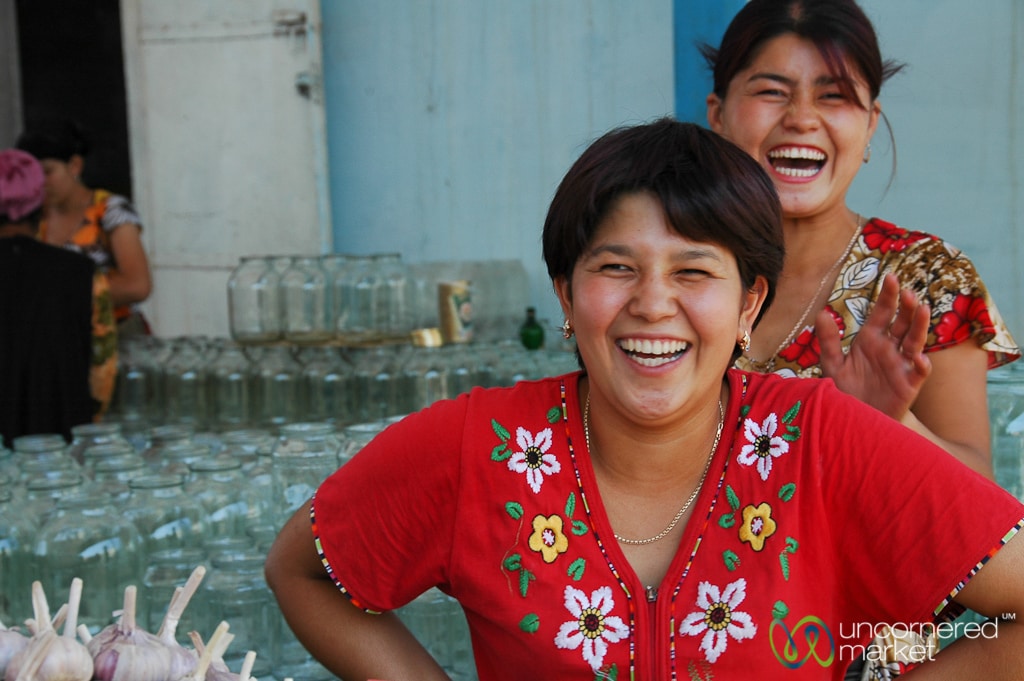
When we set off on our journey around the world over 15 years ago, we did so with the idea that to understand a place, we needed to experience it on the ground, at eye level. To walk its streets, eat its food, and talk to and interact with its people.
We observed women and their evolving role in society. It feels strange saying this as a man — and forgive me for the sweeping generalization — but in so many places (certainly not all), as men played backgammon, dominoes, and cards and drank tea or coffee all day, the women were caring for what needed to be cared for. Whether it was the home, the market stall, the community center or the school, more often than not the women, it seemed, were the ones doing.
This observation, combined with research we consumed about the impact of investing in women, accelerated our interest in projects which focused on women’s issues, including their economic and social empowerment. To complete the circle, we now consider this issue in light of how we travel and the choices we make.
Over the years we’ve asked ourselves how individual travelers might impact this cause through their own deliberate travel decisions and how travel businesses can open up more opportunities to women. This has only increased in importance as the travel went into a “great pause” during the pandemic and so many women lost their jobs and small businesses.
As travel begins to restart and rebuild in the next years there’s an opportunity now for travelers to show their support for women initiatives and business through their purchasing decisions and travel choices. Here are a few practical ways to do this.
Note: This article was originally published in 2016 in connection with a photography exhibition we were part of in Berlin called “Planet Her” focused on the role tourism can play in women’s development. It has been updated in 2021 and 2022 in light of the pandemic and restarting travel to offer more information and practical ways travelers can align their decisions and spending to support women’s initiatives and businesses.
Investing in Women: Why it Matters
There is a reason we continue to use the word “investment” in the context of women in tourism and empowerment projects. While visiting a Kiva microfinance partner outside of Cochabamba, Bolivia, we spoke to Servanda, then a borrower and member of the program.
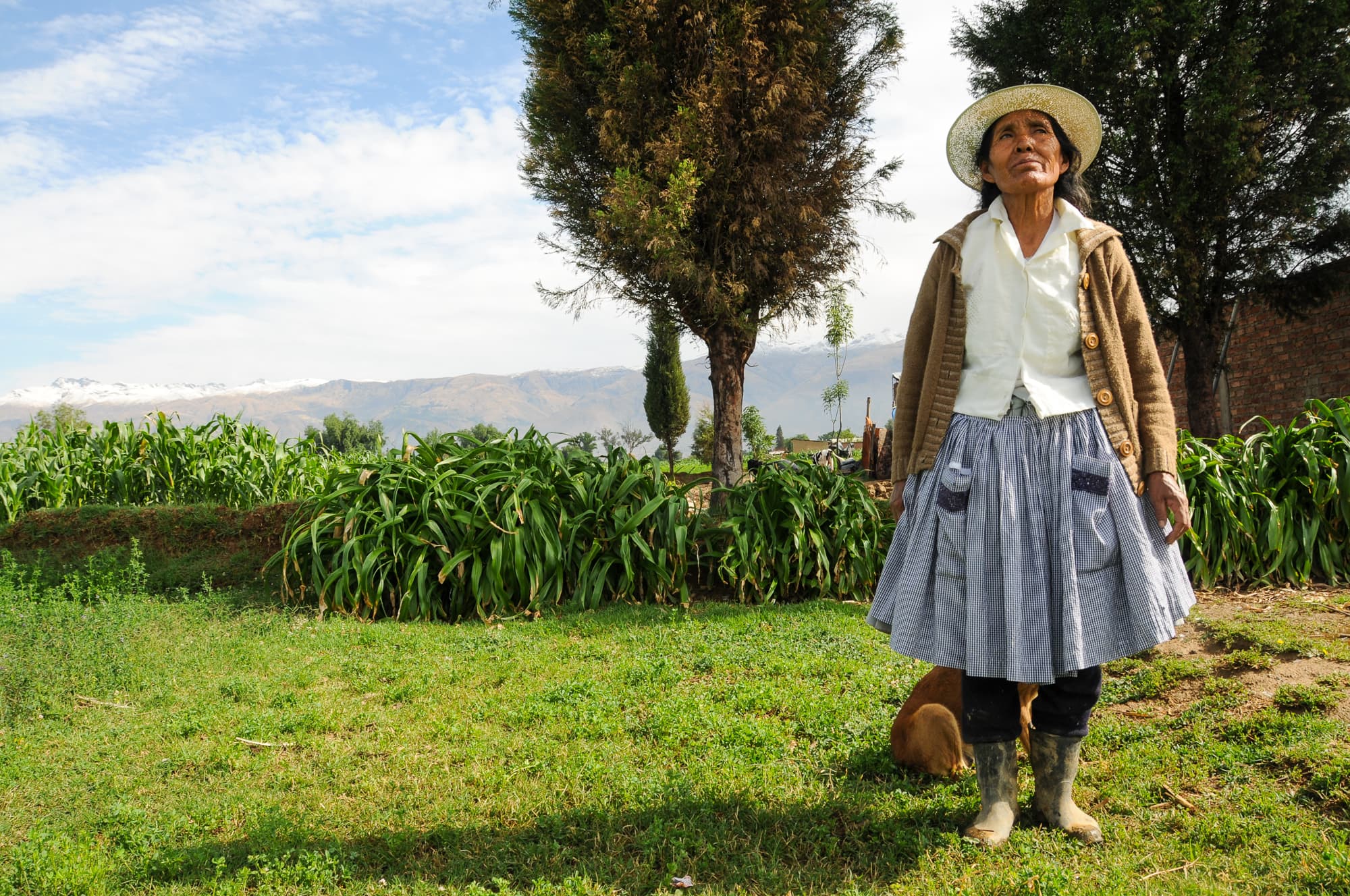 Servanda shows us her farm in a village outside Cochabamba, Bolivia.
Servanda shows us her farm in a village outside Cochabamba, Bolivia.She gave us a hint of the importance of this concept and approach: “Never before did anyone invest in us, believe in us. Even we didn’t believe we were worthy of investment, that we could build something. Now we know that we are able to create our own businesses.” She emphasized that she and her counterparts were not looking for handouts, but access.
Access. To education, to credit, and to opportunities to participate equally in society.
As we asked women involved in these projects — from India to Guatemala to Tanzania — what they would do with the fruits of their business efforts and their newly earned income, their responses echoed a similar theme.
What happens when we invest? Where will that money go when placed in the hands of women who care?
“I want to send my children to a better school.”
“I want to be able to buy better food and take them to the doctor when they need it.”
“I want my daughter to finish school, unlike me.”
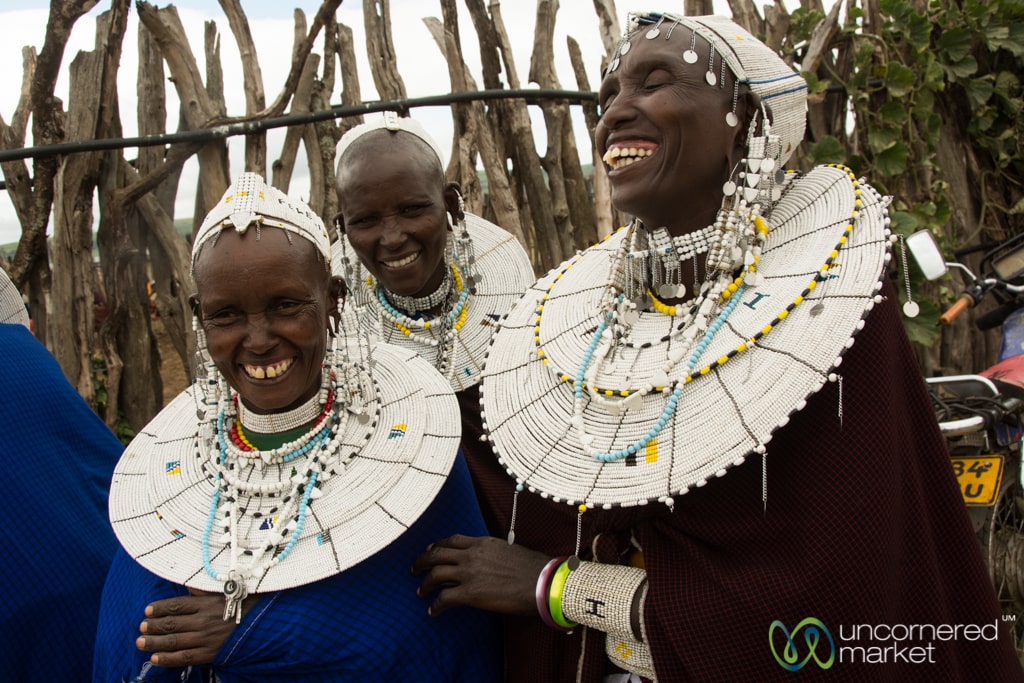 The women of the clean cookstoves project in northern Tanzania share a laugh.
The women of the clean cookstoves project in northern Tanzania share a laugh.The G Adventures and Planeterra Moshi Mamas project near Mt. Kilimanjaro in Tanzania provides business training and market access to sell crafts and services through a locally run social enterprise. Shoshe, one of its participants, summed up her aspirations and hope in the program: “I want to break the cycle for my daughter. I want to prove women can work and earn money.”
To put this in context, according to Kiva, a microfinance organization which lends money via the internet to low-income entrepreneurs around the world, women reinvest 80% of the income they earn into the education and wellbeing of children.
TL;DR: Investing in women is an investment in our future generations.
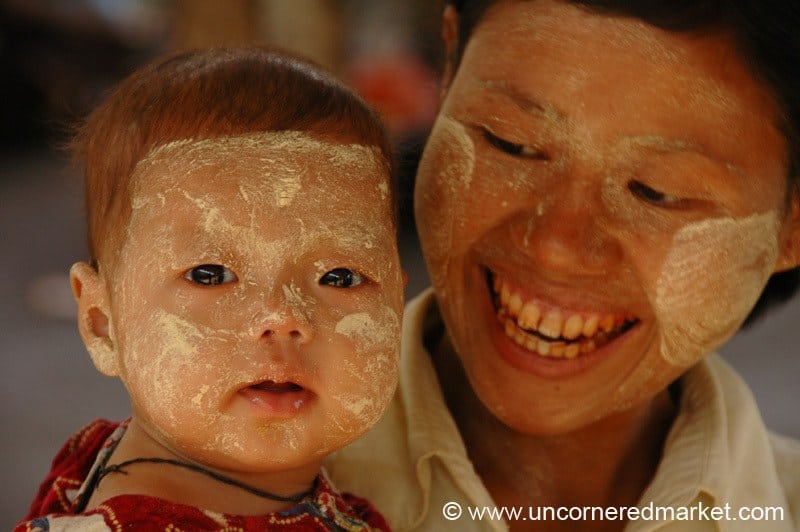 Proud mother in Myanmar.
Proud mother in Myanmar.How Travellers Can Make Decisions That Invest in and Support Local Women
At this point you might be thinking: “All this sounds great, but this investment in women is the work of NGOs and international development organizations. What can I, the average traveler, do to contribute to women’s empowerment and development? How do my choices connect to providing women access to income generation, education and services?”
Quite a bit, it turns out. When travelers align their decisions and purchases with their values, the impact on local organizations and communities can be substantial. However, travelers often don’t know where to look for travel experiences or tourism-related services that support women.
Here are a few ideas to get you started for your next trip.
1. Choose tours which incorporate a women-oriented project in the itinerary.
This may require doing a bit of research and even contacting the tour company or travel agent to ask specifics about the itinerary. Regardless, there are tour companies who work with women’s organizations, and explicitly call out this collaboration in their itineraries. Increasingly, they do this not only as a matter of expressing their values, but also to meet the growing traveler demand for engaged, cause-oriented, experience-enhancing travel interaction.
For example, Planeterra Foundation’s portfolio includes many projects that work with local organizations connected to women’s empowerment and are incorporated into G Adventures tour experiences. This means that if you travel to Nepal on a G Adventures tour you will likely take a cooking class with women from the local organization Sasane (and partner Sasane Sisterhood), an NGO which trains survivors of human trafficking to be paralegals so they can help to defend other victims.
A portion of the proceeds from the cooking class and lunch is used to fund Sasane’s projects, so it may expand both its reach and its service offering in Nepal. In this way, each traveler makes a small contribution to the Sasane mission of breaking the cycle of human trafficking in Nepal.
In this particular travel experience, the traveler learns how to make Nepalese momos (dumplings, and delicious!) and enjoys the interaction of having lunch with local women. These tours, offered continuously, host a constant stream of travelers. Sasane can count on this as a reliable source of funding for its activities and can reduce the time it spends chasing grants and charity donations. Finally and most importantly, the local women leading the instruction and experience earn money to support themselves and their families.
Recently, Sasane has used some of the guide training and assistance from Planeterra Foundation to expand their offerings to travelers to include trekking. Not only are the trekking guides survivors of human trafficking, thereby offering them employment, but some of the routes go through remote and rural areas of Nepal where trafficking is unfortunately still a big problem. One of the big goals is to build up tourism infrastructure and services (e.g., guest houses, cafes, etc.) around these routes and treks so that these rural areas have more income generating options and alternative livelihoods, thereby trying to reduce the main reason behind human trafficking: extreme poverty. Take a look at the treks and tours they offer if you’re traveling to Nepal anytime soon.
Adrienne Lee also spoke to us about the importance of travel market access these Planeterra / G Adventures initiatives provide to the local organizations they work with:
“This was a dream of one of our community development partners for close to ten years. They had received numerous training and consulting services over the last decade, but the link to a market partner (G Adventures) helped them turn around and launch their business. From our initial meetings with this partner to when G Adventures started to pilot their first groups – we launched this social business for marginalized women in less than a year. We anticipate it will be open to the public in just a few months, and the business has already started to see a four-fold increase in their revenue.”
Planeterra launched more projects, thereby offering further opportunities to connect your travels to projects that work with local women. We are particularly excited about the Rwanda project as we first visited the local organization — Nyamirambo Womens Center – during our visit to Kigali, Rwanda several years ago. We passed the organization’s contact information onto Planeterra as we were impressed with the NGO’s work in the local community.
Travelers, if you ever wonder about your impact, even suggestions based on firsthand experience can make a difference to the way business is done, and eventually to the lives of people on the ground. For us, it is satisfying to see things come full circle.
2. Seek out social enterprises that work with women and children
A social enterprise is essentially an organization that functions on one level like a business to earn money, but whose profits are given back to the community. In addition, social enterprises often train and employ people from disadvantaged or marginalized backgrounds, sometimes including those who were previously homeless, trafficked or struggling with substance-abuse issues who often don’t get a second chance. While the traveler enjoys a great meal, handmade souvenir, or walking tour, proceeds from these experiences fund the community development work of those social enterprises.
After we visited the Taj Mahal in India last year, we went to the Sheroes Hangout Cafe (She + Heroes = Sheroes) in Agra. This social enterprise cafe is run by survivors of acid attacks, a marginalized group in India. The cafe only providing a source of income and employment, but also social integration. The confidence of the strong and resilient women we met there was inspirational, as is the work they are doing on the #StopAcidAttacks campaign. The goal: that no one will ever need to go through what they did. Talk about a masala tea or curry with a cause.
Similarly, on a trip to Cambodia Audrey sought out a social enterprise offering manicures and pedicures. At Friends Nail Bar in Phnom Penh, beauty salon staff are former street children who have been given training in practical job skills through Friends International NGO; they can now support themselves through their work. Audrey emerged with nice nails and a pleasant experience, and the money she spent helped pay salaries and fund training for more young adults in similar or other job skills.
Over the last few years we’ve found more social enterprises emerging, sometimes in surprising places. To help you get started in your search for social enterprises on your next trip, consider checking out the Grassroots Volunteering social enterprise database.
3. Support women’s initiatives and women-owned businesses directly when you travel.
Think of all the services one needs as a traveler: food, tours, guiding, accommodation, transport, etc. Then ask yourself: is it possible to support or choose women-owned businesses or businesses with innovative women’s programs as you fill these needs?
Sometimes yes, sometimes no. In any event, it’s worth being aware of the possibility so that you might connect your decisions and spending with services that support women.
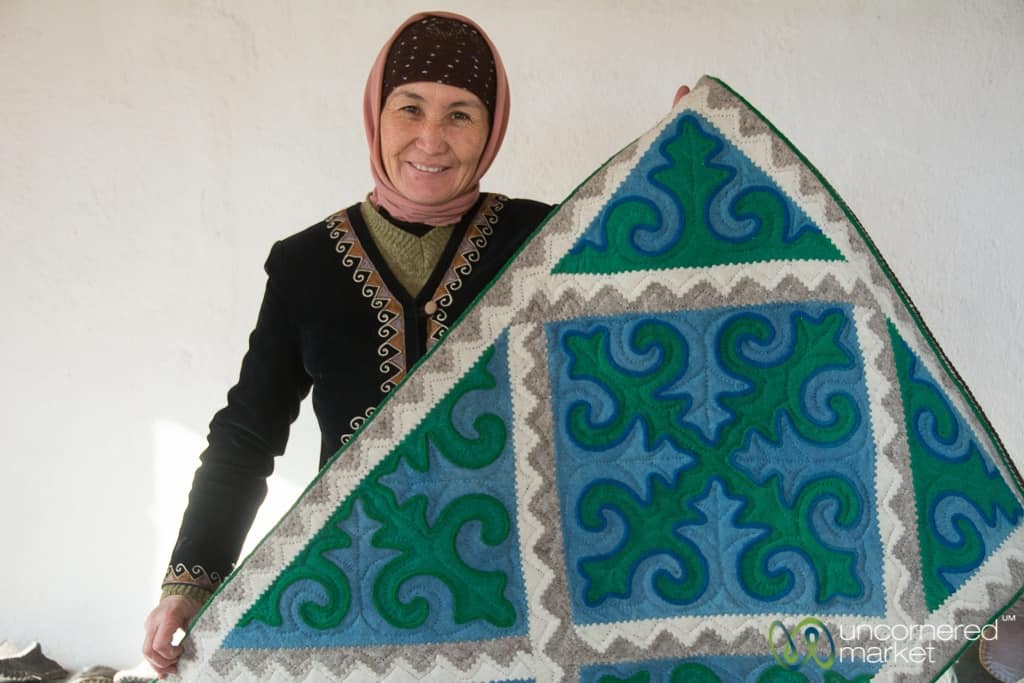 Buying a handmade Kyrgyz shyrdak (felt rug) from Golden Thimble, an NGO working with women in South Shore of Lake Issyk-Kul, Kyrgyzstan.
Buying a handmade Kyrgyz shyrdak (felt rug) from Golden Thimble, an NGO working with women in South Shore of Lake Issyk-Kul, Kyrgyzstan.This approach of linking your decisions with your values could be as seeking out restaurants and shops run by women. This could involve:
- book a trek with the first female trekking guides in the Pamir Mountains of Tajikistan
- hire a guide and porter from this women’s trekking agency in Nepal that supports and employs survivors of human trafficking
- book a taxi in Delhi, Jaipur or Kolkata in India with a female taxi driver
- choose a safari lodge in Botswana whose all-female safari guiding team was the first in the country and on the continent.
- buy souvenirs from a local women’s cooperative in Peru.
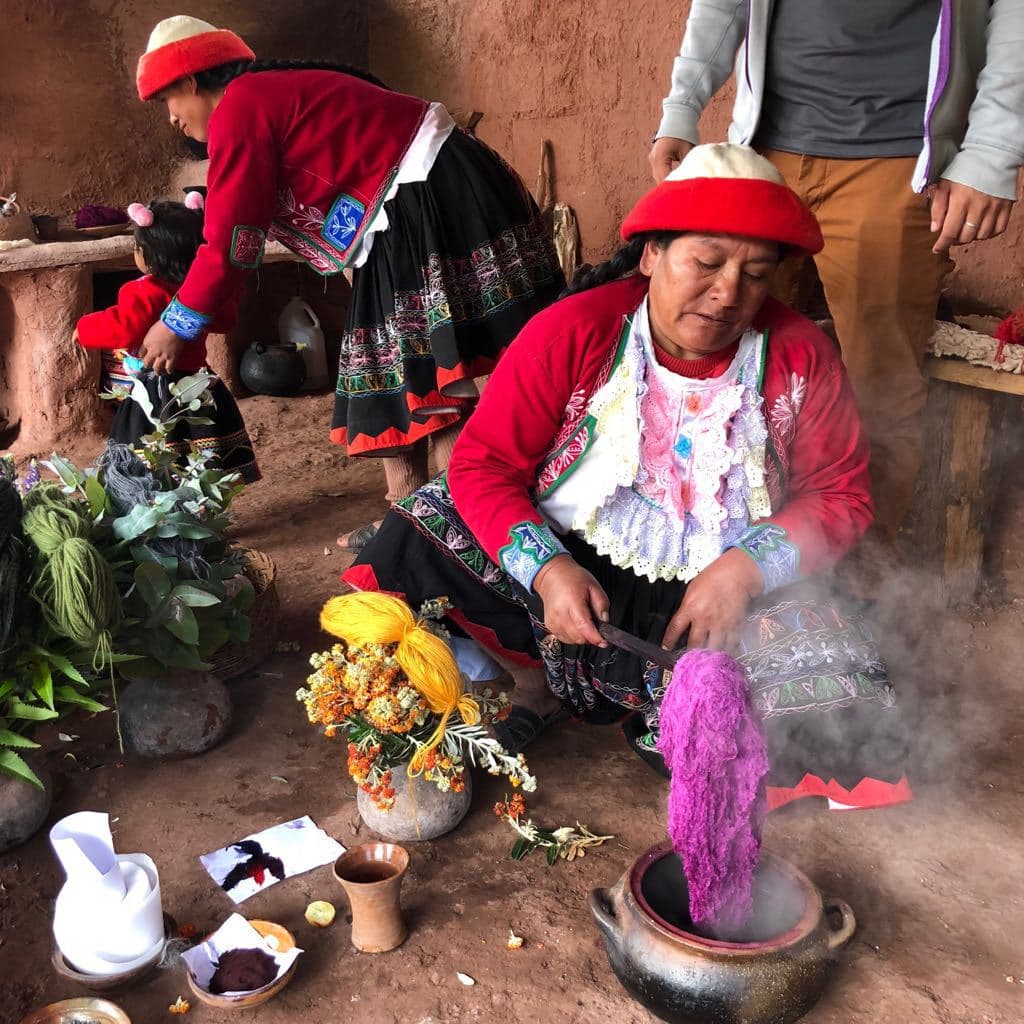 The Ccaccaccollo Women’s Weaving Cooperative in the Sacred Valley of Peru is a handicrafts social enterprise.
The Ccaccaccollo Women’s Weaving Cooperative in the Sacred Valley of Peru is a handicrafts social enterprise.For even more ideas, here is an article featuring women-led tours and travel experiences from around the world.
There are myriad ways to make an impact, however small. The choices you make do matter.
This is not only directly to the women businesses and organizations you support during your travels, but also as you show your interest and values in this through your purchasing decisions you will also send a clear message to travel companies that you expect and demand this from them. In this way, travelers have the power to push the tourism sector forward, to become even more inclusive of women and other marginalized groups.
Women: The Future
It’s no wonder that the great verbal constructs of stewardship and care — “Mother Earth”, “Pachamama”, “Mother Nature” — all position the force that underlies humanity and brings us together as that of a woman.
As we consider the world’s most pressing issues, including social and economic justice and environmental stability, maybe we ought to look more closely at this force and give it the resources it needs to innovate and craft sustainable solutions.
And when we honor women and their untapped potential, I suspect we will better serve the needs of everyone on the planet.
The post How To Support Local Women During Your Travels appeared first on Uncornered Market.